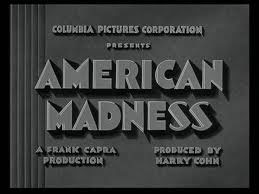 American Madness will be the feature film in March. I don’t believe we have ever run a film quite as old as this, nor one more relevant to the news of today. But mark your calendars now, for this is a film you will be glad you saw… and one which is both unusual and virtually unheard of. It boasts an excellent cast, including some Oscar winners. It is a Frank Capra film… one which recreates scenes of what it was like when their were runs on the banks. It also sounds eerily reminiscent of what one hears in today’s banking and financial news.
American Madness will be the feature film in March. I don’t believe we have ever run a film quite as old as this, nor one more relevant to the news of today. But mark your calendars now, for this is a film you will be glad you saw… and one which is both unusual and virtually unheard of. It boasts an excellent cast, including some Oscar winners. It is a Frank Capra film… one which recreates scenes of what it was like when their were runs on the banks. It also sounds eerily reminiscent of what one hears in today’s banking and financial news.
YOU MUST MAKE RESERVATIONS FOR THIS FILM
PLEASE EMAIL ME AS SOON AS POSSIBLE IF YOU PLAN TO ATTEND at piccadillyjim@clearwire.net
Few films have impressed me as much as this one in recent memory. The plot may seem a little creaky, but it moves at a rapid pace. More importantly, it is a film that resonates in modern times with our current economic difficulties. It is indeed, quite a window into the past.
The timelessness of AMERICAN MADNESS is due in part to the politics held by Frank Capra, the director, and Robert Riskin, the writer. “Capra, a conservative Italian-Catholic Republican who never voted for Franklin D. Roosevelt and Riskin, a liberal Russian-Jewish Democrat, complimented each other perfectly. They were symbiotic on every level, including that of politics. Their friendship was real, their collaboration close, mysteriously kindred and complexly interwoven. In private, they functioned as each other’s best audience.”
The plot centers around a bank president who, in the face of a terrible depression, continues to make loans to customers he believes credit worthy regardless of their ability to present any collateral… this, much against the board of directors who are trying to remove him. To further complicate matters, a bank run is made by depositors who fear the bank will go under, something which happened to thousands of banks when this film was made. The pace of this story begins to unfold slowly and then moves faster and faster, bringing the audience deeper into events which seem almost out of control.
A large part of the credit for this film goes to its cinematographer, Joseph Walker, who would receive four Oscar nominations during his long tenure covering 145 films in 33 years. Walker uses black and white lighting in such fashion as to underscore the presence of a world beset with gargantuan problems and one where all is synchronized in harmony.
The bank president is played by Walter Huston… you would have to go a long way to find a better performance. In an interview after the film’s release, he was quoted as remarking, “I figure I’m quite a bit the type of man he was, wanting from life the same things he wanted, with pretty much the same set of values and beliefs. He didn’t demand too much of his life. Neither do I. He believed in people and expected the best of them. So do I. He didn’t worry about things he couldn’t help. Neither do I. He was roused to action when there was vital and imminent need–I would be likewise. He wouldn’t have given a thought to mistakes that are done and past. I wouldn’t either. He wouldn’t have worried about what’s to come when his life is ended. I don’t. I am content to leave such matters to those who have control of them. I haven’t.”
AMERICAN MADNESS also stars Pat O’Brien, a major star for over twenty years. It was Pat O’Brien who played the role of Knute Rockne in the film biography at Warner Brothers. O’Brien starred in over 100 films.
Constance Cummings is the co-star. Relatively forgotten today, Cummings manages to show a little bit of the talent that drove her to be one of the foremost Shakespearean actresses on both sides of the Atlantic.
Finally, AMERICAN MADNESS was too uncomfortable for some of its audience when released. It opened in Baltimore the day after a bank panic, and closed less than 48 hours later… thus testifying to the bravery of Harry Cohn and Columbia studios in producing a film almost too realistic for its time.
Reservations will be accepted in the order in which they are received and you will be notified when they have been made.
One final note… This film is relatively short… 77 minutes. I doubt that we will run past nine o’clock with our program.
See you at the movies…
Paul Becker
